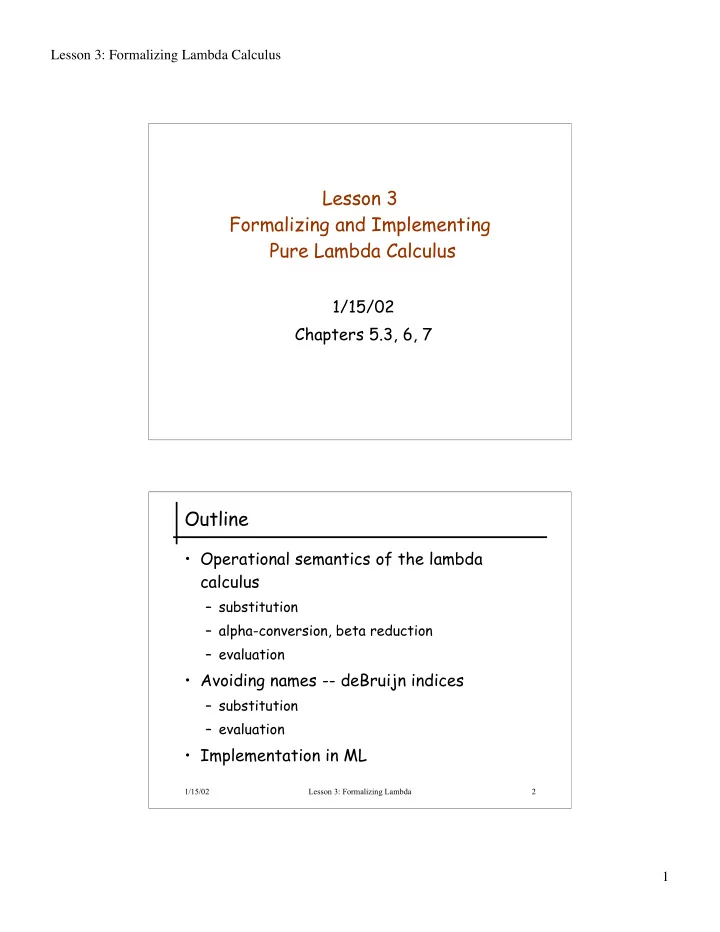

Lesson 3: Formalizing Lambda Calculus Lesson 3 Formalizing and Implementing Pure Lambda Calculus 1/15/02 Chapters 5.3, 6, 7 Outline • Operational semantics of the lambda calculus – substitution – alpha-conversion, beta reduction – evaluation • Avoiding names -- deBruijn indices – substitution – evaluation • Implementation in ML 1/15/02 Lesson 3: Formalizing Lambda 2 1
Lesson 3: Formalizing Lambda Calculus Abstract Syntax • V is a countable set of variables • T is the set of terms defined by t :: = x (x Œ V ) | l x.t (x Œ V ) | t t 1/15/02 Lesson 3: Formalizing Lambda 3 Free variables The set of free variables of a term is defined by FV(x) = {x} FV( l x.t) = FV(t) \ {x} FV(t1 t2) = FV(t1) » FV(t2) E.g. FV( l x. y( l y. xyu)) = {y,u} 1/15/02 Lesson 3: Formalizing Lambda 4 2
Lesson 3: Formalizing Lambda Calculus Substitution and free variable capture Define substitution naively by [x � s]x = s [x � s]y = y if y ≠ x [x � s]( l y.t) = ( l y.[x � s]t) [x � s](t1 t2) = ([x � s]t1) ([x � s]t2) Then (1) [x � y]( l x.x) = ( l x.[x � y]x) = ( l x.y) wrong! (2) [x � y]( l y.x) = ( l y.[x � y]x) = ( l y.y) wrong! (1) only free occurrences should be repalced. (2) illustrates free variable capture. 1/15/02 Lesson 3: Formalizing Lambda 5 Renaming bound variables The name of a bound variable does not matter. We can change bound variable names, as long as we avoid free variables in the body: Thus l x.x = l y.y but l x.y ≠ l y.y. Change of bound variable names is called a -conversion. To avoid free variable capture during substitution, we change bound variable names as needed. 1/15/02 Lesson 3: Formalizing Lambda 6 3
Lesson 3: Formalizing Lambda Calculus Substitution refined Define substitution [x � s]x = s [x � s]y = y if y ≠ x [x � s]( l y.t) = ( l y.[x � s]t) if y ≠ x and y œ FV(s) [x � s](t1 t2) = ([x � s]t1) ([x � s]t2) When applying the rule for [x � s]( l y.t), we change the bound variable y if necessary so that the side conditions are satisfied. 1/15/02 Lesson 3: Formalizing Lambda 7 Substitution refined (2) The rule [x � s]( l y.t) = ( l y.[x � s]t) if y ≠ x and y œ FV(s) could be replaced by [x � s]( l y.t) = ( l z.[x � s][y � z]t) where z œ FV(t) and z œ FV(s) Note that ( l x.t) contains no free occurrences of x, so [x � s]( l x.t) = l x.t 1/15/02 Lesson 3: Formalizing Lambda 8 4
Lesson 3: Formalizing Lambda Calculus Operational semantics (call by value) Syntax: t :: = Terms x (x Œ V ) (x Œ V ) | l x.t | t t v ::= l x.t Values We could also regard variables as values: v ::= x | l x.t 1/15/02 Lesson 3: Formalizing Lambda 9 Operational semantics: rules ( l x.t1) v2 Æ [x � v2] t1 t1 Æ t1’ t1 t2 Æ t1’ t2 • evaluate function before argument • evaluate argument before applying function t2 Æ t2’ v1 t2 Æ v1 t2’ 1/15/02 Lesson 3: Formalizing Lambda 10 5
Lesson 3: Formalizing Lambda Calculus Avoiding variables Managing bound variable names to avoid free variable capture is messy. We can avoid name clashes by eliminating variable names. De Bruijn indices are a device for replacing names with “addresses” of variables. l x.x becomes l .0 l x.x( l y.xy) becomes l .0( l .1 0) Index i refers to the i th nearest enclosing binder. 1/15/02 Lesson 3: Formalizing Lambda 11 Free variables This explains how to replace bound variables. What do we do with free variables? Assume an ordered context listing all free variables that can occur, and map free variables to their index in this context (counting right to left) Context: a, b a Ÿ 1, b Ÿ 0 l x.a Ÿ l .2, l x.b Ÿ l .1, l x.b( l y.a) Ÿ l .1( l .3) Imagine virtual l -binders for a and b around term. 1/15/02 Lesson 3: Formalizing Lambda 12 6
Lesson 3: Formalizing Lambda Calculus Substitution When substituting into a lambda term, the indices have to be adjusted: [x � z] ( l y.x) in context x,y,z [1 � 0] ( l .2) = ( l .[2 � 1] 2) = ( l .1) shift(d,c) (k) = k if k < c k+d if k >= c shift(d,c) ( l .t) = ( l .shift(d,c+1)(t)) shift(d,c) (t1 t2) = (shift(d,c) (t1)) (shift(d,c) (t2)) 1/15/02 Lesson 3: Formalizing Lambda 13 Substitution [j � s] k = s if k = j k otherwise [j � s] ( l .t) = l .[j+1 � shift(1,0)s] t [j � s] (t1 t2) = ([j � s] t1) ([j � s] t2) Beta-reduction ( l .t) v Æ shift(-1,0)([0 � shift(1,0)(v)] t) 1/15/02 Lesson 3: Formalizing Lambda 14 7
Lesson 3: Formalizing Lambda Calculus Symbols l a b Æ � ‘ Ÿ ˙ ∅ » « ⊇ Õ Ã À Œ œ ≡ 1/15/02 Lesson 3: Formalizing Lambda 15 8
Recommend
More recommend